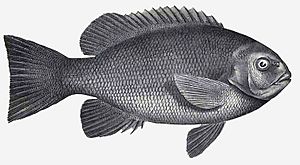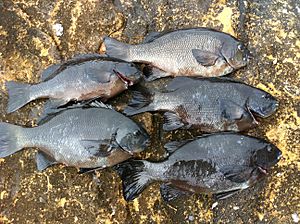Rock blackfish facts for kids
Quick facts for kids Rock blackfish |
|
|---|---|
 |
|
| FMIB 36163 Girella elevata, Macleay | |
| Scientific classification |
The rock blackfish, also known as the Eastern rock blackfish or black drummer, is a type of fish called a sea chub. Its scientific name is Girella elevata. These fish live in the ocean and are part of the Kyphosidae family. You can find them in the waters around eastern Australia and northern New Zealand.
Contents
About the Rock Blackfish
The rock blackfish has a body that is shaped like an oval. It is quite deep and flat from side to side. Its head is small, and its forehead sticks out a little. The mouth is also small and does not reach as far back as its eye.
Inside its mouth, it has two rows of teeth. The outer teeth are flat with three points, and they don't overlap. The inner teeth are similar but much smaller. The fish's body is covered in rough scales. It has a line along its side, called a lateral line, which helps it sense movement in the water. This line curves with the top of its body.
Fins and Color
The rock blackfish has a single fin on its back, called the dorsal fin. This fin has both spiny parts and soft, rayed parts. The spiny part is a bit longer than the soft part. The spines get longer towards the back, and the soft rays are longer than the spines. The soft part of the dorsal fin is rounded.
Its anal fin, which is on its underside, looks similar to the soft part of the dorsal fin. The tail fin is very large and deeply forked, like a "V" shape. It has small pectoral fins near its gills and small pelvic fins just behind them. The dorsal fin usually has 14 to 16 spines and 11 to 12 soft rays. The anal fin has 3 spines and 11 to 12 soft rays.
Adult rock blackfish are usually dark brown or grey. They have a black edge along the back of their gill cover. Young fish are not as evenly colored; they have darker spots and bands on their backs. These fish can grow up to 62 centimeters (about 2 feet) long. They usually weigh between 1 to 2 kilograms (2 to 4 pounds), but some can weigh over 3 kilograms (6.6 pounds).
Where Rock Blackfish Live
You can find Girella elevata in the coastal waters of the southwestern Pacific Ocean. They live along the eastern coast of Australia and in northern New Zealand.
In Australia, they are found from Noosa Heads in Queensland, south to Apollo Bay in Victoria. They are also seen in northern Tasmania. However, they are not very common west of Wilsons Promontory in Victoria. These fish also live around Lord Howe Island, which is in the Tasman Sea.
Habitat and Life Cycle
Adult rock blackfish prefer to live in rocky reef areas. They like places where the ocean waves crash, from the shallow surf zone down to about 25 meters (82 feet) deep. Divers often see them hiding in caves or under ledges.
Young rock blackfish, called juveniles, live in rockpools, estuaries, and shallow rocky areas. These fish can live for a very long time, sometimes up to 45 years! They are omnivores, which means they eat both plants and animals. Their diet includes different small sea creatures and various types of algae.
Fishing for Rock Blackfish
The rock blackfish is a popular fish for people who enjoy recreational fishing. Anglers like them because they are known to be very strong fighters when caught on a hook. Some people even call them "pigs" because of how hard they fight. Another reason for this nickname might be the sounds they make when caught, or because they are considered good to eat.
Most people who fish for rock blackfish do so from the land. This is because these fish prefer to live in the foamy white water around rocky areas right along the coast. Catching them from a boat is possible, but it can be risky because you have to fish very close to the shore.
Tips for Anglers
Rock blackfish are powerful fish for their size. Their large tail fin helps them move easily in the rough, turbulent water near the coast. The best times to fish for them are usually around high tide, or during times when there isn't much light, like dawn or dusk. They also seem to be more active when the ocean is rougher. However, anglers must be very careful and safe when fishing in high seas.
To catch them, anglers first need to find a safe spot that looks like a good place for rock blackfish to live. This is usually deeper water next to a rocky outcrop. Fishermen then use a bread-based mix, called berley, to attract the fish.
Bait and Gear
Since rock blackfish eat many different things, they will bite on various baits. Popular choices include cunjevoi (a type of sea squirt), peeled prawns, bread, and sea cabbage. The bait should be weighted lightly so it moves naturally in the white water, just like real food.
Anglers need to keep feeling their fishing line. If the bait sinks too deep, it can get stuck on rocks or kelp below. But if the bait doesn't sink deep enough, it won't reach the rock blackfish. These fish often hide in overhangs and caves several meters (feet) below the surface. This type of fishing can be tricky and takes practice.
Fishing setups for rock blackfish are usually simple. Anglers often use a strong fishing line, about 11 kilograms (24 pounds) in strength. They might use a running ball sinker rig, where a small sinker slides freely on the line just above the hook. Another method is to hang the bait below a floating cork. Strong hooks are important for this kind of fishing.
Discovery of the Species
The rock blackfish, Girella elevata, was first officially described by a scientist named William John Macleay in 1881. The first fish of this species that was studied came from Port Jackson in New South Wales, Australia.


